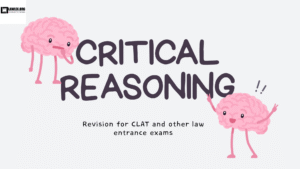With CLAT 2026 approaching, here is a quick revision sheet for your Critical Reasoning Section.
- An argument consists of two parts- premise and conclusion. A premise is a statement or fact that the author is trying to explain in the argument, whereas a conclusion is the sum of the author’s premises.
- What is inference, then and how is it different from a conclusion?
| Inference | Conclusion |
| 1. It uses facts to determine other facts. | 1. It is the next logical step in the information series. |
| 2. Examine the facts and see what they determine. | 2.It must be logically derived and not inferred. |
| 3. It is an educated guess. | 3.It is based on facts and details. |
Eliminate options: 1. Contradictory
- Out of scope
- Too broad/extreme
- How to find the central idea?
A] Read the whole passage
B] notice transition in words and tone.
The main idea should contain all the main topics that the passage suggests.
Therefore, we can say the main idea is a RECURRING THEME
- Assumption
It is an unstated/implicit premise that needs to be true for the conclusion to be valid.
Approach- find the conclusion and the premise, and then find a connecting link which will be your assumption. Try to have an answer in your mind before looking at the options.
- Weaken/strengthen argument
Strategy- 1. Read the argument and identify the premise.
- Identify the gaps.
- You can bring new information that is outside the scope of the passage.
Question stems for weaken- 1. Casts more doubt
- undermines
- damages
- refutes/contradicts/goes against
Question stems for strengthening- 1. Strongly support
- does most to justify
- bolsters
- Flaws in the argument
- Hasty generalisation- an argument based on insufficient and unrepresentative evidence.
- Faulty analogy- assuming that two things are alike in one aspect, so they will be alike in other aspects as well.
- Casual fallacy- I. Post hoc ergo propter hoc [after this, therefore because of this]
- Cum hoc ergo propter hoc [ with this, therefore because of this]
- Statistical fallacy- using a small survey, biased sampling, and comparing percentages with numbers.
- Personal attack [ad hominem]– attack on a person’s character or circumstances
- Circular reasoning
- Changing subject [red herring]– irrelevant point introduced to divert the reader’s attention.
- Explain the discrepancy/resolve the paradox
Two ideas/situations are given that will contradict each other. You will need to resolve the discrepancy.
Strategy – 1. Identify the contrast
- Eliminate those that explain only one side or contradict the argument.
Question stems- resolve paradox/ conflict/dichotomy/incongruity/contradiction/analogy.
- Evaluate the argument
Evaluate: assess or judge. It is a combination of strength and weakness.
Identify a question that, when answered, helps evaluate how sound the conclusion is. Subject each option to yes or no, 0 or 100.
Eliminate- irrelevant, completely weaken, completely strengthen.
- Method of reasoning
You have to choose a method used by the author to make the argument.
Strategy- 1. Identify premise and conclusion.
- Identify whether the second argument weakens or strengthens the first argument.
- Eliminate choices that do not match.
- Parallel reasoning
A scenario involving a chain of reasoning is given. Select answers of different scenarios but similar chain of reasoning.
Strategy- identify the chain of reasoning and look for core reasoning
Question stems- 1. Exemplifies the argument.
- closely parallels the reasoning.
- Implicit– means which implies and is directly given in the passage.
- Explicit– not mentioned in the passage.
- Cause and effect
Check if there exists a cause-and-effect relation and then evaluate which is the cause and which is the effect.
- Course of action
Problematic situation given. Decide what action you will take and in which order.
- Tips for Critical Reasoning
- After reading each paragraph, write a summary in your own words.
- At every question, frame your own answers and predict
- Predict before checking options if possible. Then check your prediction and mark the answer.
Last but not least, trust yourself. Don’t think in extremes. Sometimes, your gut feeling will guide you the right way. Aim big and achieve big!
All the best for your exam from Team LawLex!


